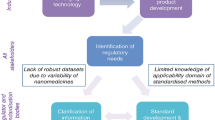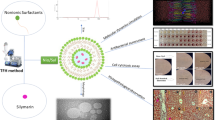Abstract
Todays, using nano-based drug delivery systems as suitable carriers can help in controlling release of drug to target cells. In current study, multi-walled carbon nanotube (MWCNTs) have been proposed as a suitable carrier (adsorbent) for improvement of pantoprazole (PTZ) drug delivery. The PTZ adsorption on the MWCNT has been assayed using three well-known Langmuir, Freundlich, and Temkin isotherm models. High value of isotherm constant (KL = 0.143 L mg−1) and low separation factor (RL = 0.24) imply strong and desirable adsorption of the PTZ on the MWCNT with 1.00 mg L−1 concentration at 298-K temperature and acidic medium, pH = 6.0. More importantly, decreasing the PTZ adsorption and dehydrogenation mainly result from increasing pH factor. Negative thermodynamic parameter such as ΔH = − 6.31 kJ mol−1 based on Van’t Hoff equation shows that the PTZ adsorption has fast kinetic in pseudo-second-order kinetic model (R2 = 1.00) and exothermic processes at 25 min. In density functional theory framework, high global softness (0.24 eV) of the PTZ and more negative adsorption energy (− 6.02 kJ mol−1) reveal that this compound transfers by using MWCNT. These issues imply that MWCNT is suitable carrier in order to control release of the PTZ drug to target cells without side effects.





Similar content being viewed by others
Availability of data and material
Detail of experimental and theoretical parts are given in supporting information.
Code availability
All data generated or analysed during this study are included in this published article (and its supplementary information files).
References
Debbage P (2009) Targeted drugs and nanomedicine: present and future. Curr Pharm Des 15:153–172. https://doi.org/10.2174/138161209787002870
Prato M, Kostarelos K, Bianco A (2008) Functionalized carbon nanotubes in drug design and discovery. Acc Chem Res 41:60–68. https://doi.org/10.1021/ar700089b
Xu L, Jiang S, Wu J, Zou Q (2021) An in silico approach to identification, categorization and prediction of nucleic acid binding proteins. Brief Bioinform 22. https://doi.org/10.1093/bib/bbaa171
Karimi EZ, Zebarjad SM, Khaki JV, Izadi H (2010) Production of carbon nanotubes using mechanical milling in the presence of an exothermic reaction. J Alloys Compd 505:37–42. https://doi.org/10.1016/j.jallcom.2010.06.021
Moghassemi S, Hadjizadeh A (2014) Nano-niosomes as nanoscale drug delivery systems: an illustrated review. J Control Release 185:22–36. https://doi.org/10.1016/j.jconrel.2014.04.015
Mohammadi M, Vadi M, Bagehri N et al (2021) Kinetics and thermodynamics adsorption of oxazepam drug on the multi-walled carbon nanotube. J Chinese Chem Soc 68:799–805. https://doi.org/10.1002/jccs.202000407
Ghoreishi R, Kia M (2019) Chemical reactivity and adsorption properties of pro-carbazine anti-cancer drug on gallium-doped nanotubes: a quantum chemical study. J Mol Model 25:46. https://doi.org/10.1007/s00894-018-3914-2
Esmaeili S, Samadizadeh M, Khaleghian M (2020) Evaluating role of the x–π (x = π and/or CH) stacking interactions in adsorption of the (4E,4E)-4-(4-hydroxyphenyldiazenyl)-N-((furan-2-Yl)methylene)benzenamine antibacterial in armchair boron nitride nanotube. Chem Pap 74:2991–3000. https://doi.org/10.1007/s11696-020-01137-x
Scheibe B, Borowiak-Palen E, Kalenczuk RJ (2010) Enhancement of thermal stability of multiwalled carbon nanotubes via different silanization routes. J Alloys Compd 500:117–124. https://doi.org/10.1016/j.jallcom.2010.03.229
Wang X-F, Gao P, Liu Y-F et al (2020) Predicting thermophilic proteins by machine learning. Curr Bioinform 15:493–502. https://doi.org/10.2174/1574893615666200207094357
Zou Q, Xing P, Wei L, Liu B (2019) Gene2vec: gene subsequence embedding for prediction of mammalian N 6 -methyladenosine sites from mRNA. RNA 25:205–218. https://doi.org/10.1261/rna.069112.118
Eshghi F, Ghahramani Z, Ghoreishi R, Ghahremani S (2021) Improvement of floxuridine anti-cancer adsorption on boron carbonitride nanotubes with iron doping: a theoretical study. Theor Chem Acc 140:119. https://doi.org/10.1007/s00214-021-02823-z
Klingeler R, Sim RB (2011) Carbon nanotubes for biomedical applications. Springer, Berlin. ISBN: 978-3-642-26709-3
Benito P, Herrero M, Labajos FM et al (2009) Production of carbon nanotubes from methane: use of Co-Zn-Al catalysts prepared by microwave-assisted synthesis. Chem Eng J 149:455–462. https://doi.org/10.1016/j.cej.2009.02.022
Yu J, Huang K, Yang Q et al (2008) Progress in the research of carbon nanotubes as drug carriers. Yao Xue Xue Bao 43:985–991
Nagai H, Okazaki Y, Chew SH et al (2011) Diameter and rigidity of multiwalled carbon nanotubes are critical factors in mesothelial injury and carcinogenesis. Proc Natl Acad Sci 108:E1330–E1338. https://doi.org/10.1073/pnas.1110013108
Guo L, Von Dem Bussche A, Buechner M et al (2008) Adsorption of essential micronutrients by carbon nanotubes and the implications for nanotoxicity testing. Small 4:721–727. https://doi.org/10.1002/smll.200700754
Sobh RA, Hanaa El-Sayed Nasr WSM (2019) Formulation and in vitro characterization of anticancer drugs encapsulated chitosan/multi-walled carbon nanotube nanocomposites. J Appl Pharm Sci 9:32–40. https://doi.org/10.7324/JAPS.2019.90805
Zhu W, Huang H, Dong Y et al (2019) Multi-walled carbon nanotube-based systems for improving the controlled release of insoluble drug dipyridamole. Exp Ther Med 17:4610–4616. https://doi.org/10.3892/etm.2019.7510
Fitton A, Wiseman L (1996) Pantoprazole Drugs 51:460–482. https://doi.org/10.2165/00003495-199651030-00012
Cheer SM, Prakash A, Faulds D, Lamb HM (2003) Pantoprazole Drugs 63:101–133. https://doi.org/10.2165/00003495-200363010-00006
Ortiz de García S, Pinto Pinto G, García Encina P, Irusta Mata R (2013) Consumption and occurrence of pharmaceutical and personal care products in the aquatic environment in Spain. Sci Total Environ 444:451–465. https://doi.org/10.1016/j.scitotenv.2012.11.057
Huber R, Hartmann M, Bliesath H et al (1996) Pharmacokinetics of pantoprazole in man. Int J Clin Pharmacol Ther 34:185–194
Moreira Dias L (2009) Pantoprazole. Clin Drug Investig 29:3–12. https://doi.org/10.2165/1153121-S0-000000000-00000
Krag M, Marker S, Perner A et al (2018) Pantoprazole in patients at risk for gastrointestinal bleeding in the ICU. N Engl J Med 379:2199–2208. https://doi.org/10.1056/NEJMoa1714919
Jungnickel PW (2000) Pantoprazole: a new proton pump inhibitor. Clin Ther 22:1268–1293. https://doi.org/10.1016/S0149-2918(00)83025-8
Miner P (2003) Gastric acid control with esomeprazole, lansoprazole, omeprazole, pantoprazole, and rabeprazole: a five-way crossover study. Am J Gastroenterol 98:2616–2620. https://doi.org/10.1016/j.amjgastroenterol.2003.09.053
Moayyedi P, Eikelboom JW, Bosch J et al (2019) Pantoprazole to prevent gastroduodenal events in patients receiving rivaroxaban and/or aspirin in a randomized, double-blind, placebo-controlled trial. Gastroenterology 157:403-412.e5. https://doi.org/10.1053/j.gastro.2019.04.041
Koh JS, Joo MK, Park J-J et al (2018) Inhibition of STAT3 in gastric cancer: role of pantoprazole as SHP-1 inducer. Cell Biosci 8:50. https://doi.org/10.1186/s13578-018-0248-9
Dağlı Ü, Kalkan İH (2017) Treatment of reflux disease during pregnancy and lactation. Turkish J Gastroenterol 28:S53–S56. https://doi.org/10.5152/tjg.2017.14
Gravell A, Fones GR, Greenwood R, Mills GA (2020) Detection of pharmaceuticals in wastewater effluents—a comparison of the performance of Chemcatcher® and polar organic compound integrative sampler. Environ Sci Pollut Res 27:27995–28005. https://doi.org/10.1007/s11356-020-09077-5
Chen Y, Wu S, Yang Q (2020) Development and validation of LC-MS/MS for analyzing potential genotoxic impurities in pantoprazole starting materials. J Anal Methods Chem 2020. https://doi.org/10.1155/2020/6597363
Jadon N, Sharma HK (2020) PANI/chitosan/ionic liquid/GCE sensor for the selective quantification of domperidone (DMP) and pantoprazole (PTZ). Anal Chem Lett 10:537–549. https://doi.org/10.1080/22297928.2020.1837668
Manjunatha P, Arthoba Nayaka Y, Purushothama HT et al (2019) Single-walled carbon nanotubes-based electrochemical sensor for the electrochemical investigation of pantoprazole in pharmaceuticals and biological samples. Ionics (Kiel) 25:2297–2309. https://doi.org/10.1007/s11581-018-2624-1
Frisch MJ, Trucks GW, Schlegel HB, Scuseria GE, Robb MA, Cheeseman JR, Scalmani G, Barone V, Petersson GA, Nakatsuji H, Li X, Caricato M, Marenich A, Bloino J, Janesko BG, Gomperts R, Mennucci B, Hratchian HP, Ortiz JV, Izmaylov AF, Sonnenberg JL, Williams-Young D, Ding F, Lipparini F, Egidi F, Goings J, Peng B, Petrone A, Henderson T, Ranasinghe D, Zakrzewski VG, Gao J, Rega N, Zheng G, Liang W, Hada M, Ehara M, Toyota K, Fukuda R, Hasegawa J, Ishida M, Nakajima T, Honda Y, Kitao O, Nakai H, Vreven T, Throssell K, Montgomery JA, Jr, Peralta JE, Ogliaro F, Bearpark M, Heyd JJ, Brothers E, Kudin KN, Staroverov VN, Keith T, Kobayashi R, Normand J, Raghavachari K, Rendell A, Burant JC, Iyengar SS, Tomasi J, Cossi M, Millam JM, Klene M, Adamo C, Cammi R, Ochterski JW, Martin RL, Morokuma K, Farkas O, Foresman JB, Fox DJ, Gaussian, Inc (2009) Gaussian 09 revision A. 1. Gaussian, Inc,. Wallingford, CT, USA
Pakiari AH, Eshghi F (2017) Geometric and electronic structures of vanadium sub-nano clusters, Vn(n = 2–5), and their adsorption complexes with CO and O2 ligands: a DFT-NBO study. Phys Chem Res 5. https://doi.org/10.22036/pcr.2017.80624.1364
RG. Parr WY, (1989) Density-functional theory of atoms and molecules. Oxford University Press, New York
Reed AE, Weinstock RB, Weinhold F (1985) Natural population analysis. J Chem Phys 83:735–746. https://doi.org/10.1063/1.449486
Reed AE, Weinstock RB, Weinhold F (1985) NBO, Version 3.1.(b). J Chem Phys 83
Duarte AS, Rehbinder J, Correia RRB et al (2013) Mapping impurity of single-walled carbon nanotubes in bulk samples with multiplex coherent anti-stokes Raman microscopy. Nano Lett 13:697–702. https://doi.org/10.1021/nl304371x
Aharoni C, Ungarish M (1977) Kinetics of activated chemisorption. Part 2.—Theoretical models. J Chem Soc Faraday Trans 1 Phys Chem Condens Phases 73:456. https://doi.org/10.1039/f19777300456
Freundlich H (1906) Über die Adsorption in Lösungen. Habilitationsschrift durch welche... zu haltenden Probevorlesung" Kapillarchemie und Physiologie" einladet Dr. Herbert Freundlich. W. Engelmann
Langmuir I (1917) The constitution and fundamental properties of solids and liquids. II Liquids J Am Chem Soc 39:1848–1906
Temkin M, Pyzhev V (1940) Kinetics of ammonia synthesis on promoted iron catalysts. Acta Physicochim URSS 12:327–356
Foo KY, Hameed BH (2010) Insights into the modeling of adsorption isotherm systems. Chem Eng J 156:2–10
Gehlot G, Verma S, Sharma S, Mehta N (2015) Adsorption isotherm studies in the removal of malachite green dye from aqueous solution by using coal fly ash. Int J Chem Stud 3:42–44
Senturk HB, Ozdes D, Gundogdu A et al (2009) Removal of phenol from aqueous solutions by adsorption onto organomodified Tirebolu bentonite: equilibrium, kinetic and thermodynamic study. J Hazard Mater 172:353–362
Chen Z, Fu J, Wang M et al (2014) Adsorption of cationic dye (methylene blue) from aqueous solution using poly(cyclotriphosphazene-co-4,4′-sulfonyldiphenol) nanospheres. Appl Surf Sci 289:495–501. https://doi.org/10.1016/j.apsusc.2013.11.022
Lagergren S, Lagergren S, Lagergren SY, Sven K (1898) Zurtheorie der sogenannten adsorption gelösterstoffe
Ho YS, McKay G (1999) Pseudo-second order model for sorption processes. Process Biochem 34:451–465. https://doi.org/10.1016/S0032-9592(98)00112-5
Acknowledgements
The authors gratefully thank Dr. Fazlolah Eshghi for his suggestions and help in this study.
Author information
Authors and Affiliations
Contributions
Mehdi Vadi conceived of the presented idea. Neda Sadeghpour carried out computational jobs and experiments. Neda Sadeghpour and Narges Bagheri wrote the manuscript and discussed the results and contributed to the final manuscript.
Corresponding author
Ethics declarations
Conflict of interest
The authors declare no competing interests.
Additional information
Publisher's Note
Springer Nature remains neutral with regard to jurisdictional claims in published maps and institutional affiliations.
Supplementary Information
Below is the link to the electronic supplementary material.
Rights and permissions
About this article
Cite this article
Sadeghpour, N., Vadi, M. & Bagheri, N. Engineering delivery of pantaprazole drug using multi-walled carbon nanotubes: an experimental and theoretical study. Struct Chem 33, 733–742 (2022). https://doi.org/10.1007/s11224-022-01883-6
Received:
Accepted:
Published:
Issue Date:
DOI: https://doi.org/10.1007/s11224-022-01883-6




